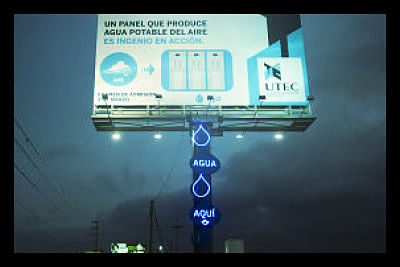Water Billboards: Turning Humidity Into Potable Water

Receiving only a half-inch of precipitation annually, the 7.6 million residents of Lima, Peru are in the midst of a serious water shortage. One point two million Limans do not have running water at all, and 700,000 people have no access to clean water for drinking or bathing. With advanced climate change affecting the natural water sources of the Andes, engineers from Peru’s University of Engineering and Technology (UTEC) have turned to science, and specifically water billboards, for an answer.
Like a magician pulls a rabbit from a hat, they’ve figured out a way to pull water from thin air.
The process of scientific magic occurs inside a billboard in Lima’s Bujama District, erected by a group of UTEC engineers in partnership with marketers from the Mayo Publicidad ad agency. The billboard takes advantage of Lima’s high degree of humidity, nearly 90 percent in the summer months, and transforms this moisture into usable water.
When moist air hits the billboard, five condensers cool it and convert it into liquid form. The newly created water goes through reverse-osmosis purification and then flows into a 20-liner storage tank at the billboard’s base. The filtration system is simple and straightforward, though not entirely self-sufficient, because it uses electricity from Lima’s power lines.
Active for 3 months, the billboard has had a significant effect. It has produced nearly 2,500 gallons of water, averaging 26 gallons a day. According to the UTEC engineers involved, this is equivalent to the water consumption of hundreds of families per month.
Efforts have been made in the past to magically pull water from the air. Most notably Eole, a French company, installed a wind turbine in Abu Dhabi that was said to generate more than 370 gallons of water a day. The commercial launch of this technology, however, came at too high of a price.
That’s the genius of UTEC’s water billboard – if the technology expands, it will be inexpensive to install thanks to funding from advertisers. The inaugural billboard costs only $1,200 to construct, and advertises both UTEC and the technology itself. UTEC has not gone unrewarded, since the erection of the billboard enrollment has substantially increased. It hopes that companies will see UTEC’s own results and seek to advertise on water billboards themselves.
It is unclear whether more billboards like this one will be installed throughout Lima, but UTEC’s water billboard has successfully started new discussions about providing clean water. Advertising can be more than a commercial tool; it has potential as an effective method of helping those in need.
– Katie Pickle
Sources: Popular Mechanics, Time
Photo: Fast Coexist
